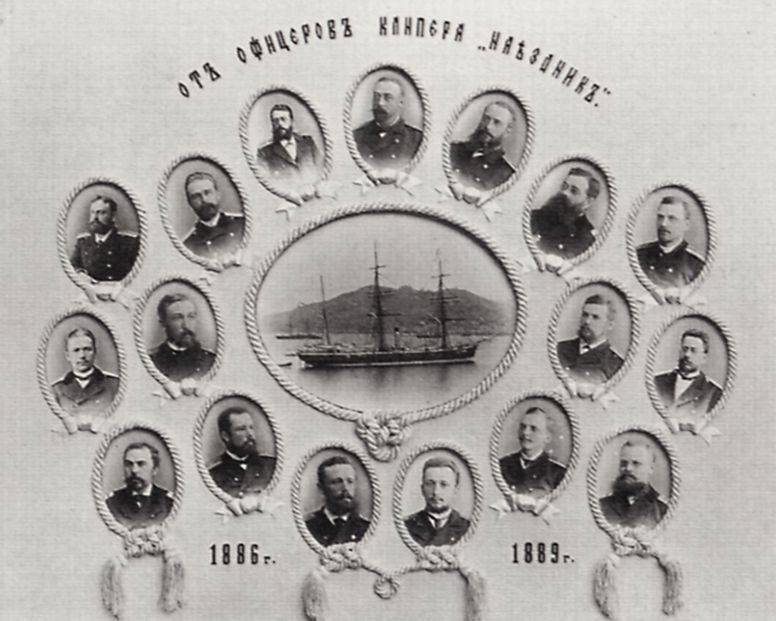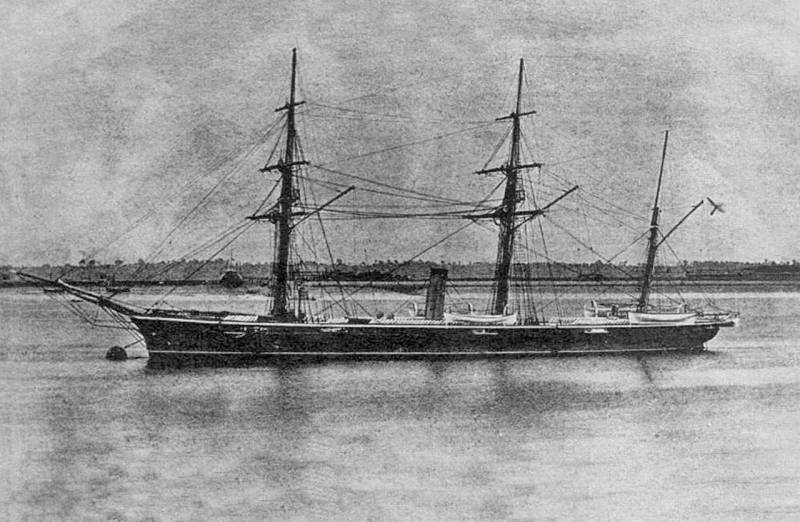Clippers of the Russian Imperial Navy

The year was 1855 and it was decided to build steam ships in Arkhangelsk to protect the Russian North:
There were many problems, primarily with steam engines, but they were solved, and in January 1855 six ships ("Robber", "Oprichnik", "Shooter", "Plastun", "Rider" and "Dzhigit") were laid in Arkhangelsk Admiralty. The ships came out pretty good:
But they did not have time for the Crimean War, and it was decided to use them in the Far East. The decision is the only reasonable - in Europe, a big war in the near future became impossible, and to train personnel for a new steam fleet was necessary. And it is better to prepare them on long voyages and in an environment close to combat. Although at first there was the Baltic, where the newly built sail-propeller ships went immediately after construction. And from there, from 1857 to 1859, they went to the Far East. The ships gave the impression:
But their life turned out to be short and rather tragic. Two of the six ships perished - the Plastun in the Baltic in 1860 from the explosion of the cruise chamber, and the Oprichnik in the Indian Ocean simply disappeared, there are many versions, but the truth went to the bottom along with the ship. The rest of the four returned to another Kronstadt and to the other Baltic fleet, the steam and armored fleet, where there was no place for clippers of this type. Yes, and there was no money for repairs after the most difficult service and campaign, the fleet had a priority in the monitors for the defense of St. Petersburg. As a result, in 1866, very young ships were handed over to the port, and from 1867 they began to be excluded. One was disassembled, two became targets for mines and shells, the only "Shooter" became a hulk and held out in this capacity until 1878.
The ships left, but the beginning of a new class of ships in our fleet was laid.
Second series
The second series of sail-screw clippers turned out to be happier, maybe because they were "foreigners" in construction, but they were built and designed slowly and not during the war, or maybe because the experience of operating ships of this class has already accumulated ...
"Gaidamak", built in England in 1860, immediately went to the Far East under the command of Lieutenant Peshchurov.
The path was not easy: Brazil - Batavia - Hong Kong - Shanghai, and then there was a service. Exploration of the Peter the Great Bay and the discovery of the Gaydamak Bay, the exploration of the Nakhodka Bay, a trip to Sakhalin, where in Douai, when loading coal, the clipper was stranded. They wanted to write off the ship, but in the end they rescued and the service continued.
Trips to China, Siam, the Philippines, the future writer Stanyukovich served on the clipper. Popov's Pacific expedition to the United States to support the North against the South (in fact, against England).
The Clipper traveled many miles and many countries, but the "Haidamaks" returned home only in 1864. He returned for repairs and training, so that in 1869 he again went to the Far East. The second trip was much more boring and calmer, for three years the clipper was essentially used as a transport.
There was also a third campaign, and research in the Polar region, and a new expedition to the United States, and the inclusion of Lesovsky in the squadron in 1880. Five years later, one of the most famous Russian ships of the 19th century was decommissioned.
The second clipper "Abrek", built in Finland, largely repeated the fate of "Gaydamak", with the exception of the final. After the disbandment of Lesovsky's squadron, the clipper remained in the Far East, guarded the fur seal fisheries, then served as a block ship in Vladivostok. Indirectly, the hull took part in the Russo-Japanese War, serving as a heater for a submarine detachment. The blockchain was disassembled only in 1908.
The "Horseman", under the command of Lieutenant-Commander Birilyov, turned out to be less happy, having started his service with a run aground during tests in the Baltic. In 1866, he also went to the Far East, where he served on Sakhalin. The second trip - exploration of the coast of Chukotka and the Second American Expedition. Decommissioned in 1881 in the Baltic.
Third episode
"Kamushki" ("Pearl", "Almaz", "Izumrud", "Yakhont") were built in Russia in 1860-63. A little more displacement, higher speed under steam (13 knots), higher range and more modern weapons. Their fate was also typical for ships of that time - campaigns to the Far East were replaced by exercises and repairs in the Baltic, in order to go to the Far East again. The "Izumrud" clipper, who took part in the Miklouho-Maclay expedition, became famous. The ships were reliable even after many years of service.
But their time has passed, and no one began to spend money on the modernization and rearmament of wooden cruisers. Despite the quality of construction and the reliability of the mechanisms, completely different ships already reigned in the sea.
Fourth series
Ten years after the pebbles, the construction of the second generation clippers - of the "Cruiser" type, began. They were perfect for their class, once again proving the benefits of serial construction and the smooth development of a ship type from type to type, but they were late. This is not the fault of the designers: at the time the construction of the Cruiser began, such ships were still relevant, by the time the Oprichnik was completed, in 1881 they were already outdated. In that era, when the ships were still outdated on the stocks, the result, in principle, was normal, the more they brought benefits to the fleet, and two of them took part in the Russian-Japanese war, on roles, of course, tertiary, but still in quality combat ships.
They were already conceived of steel, but in the end only three became such - expensive and corrosion, which they still did not know how to effectively deal with, and these cruisers are designed for long-distance cruises and service where there are no normal bases and are not expected. As a result, after the campaigns to the Far East, these ships became training ships, although their page in stories fleet they painted in bright colors. For example, the "Robber" made two trips around the world, participated in the founding of Anadyr, visited England ... The "Rider" went to the homeland of this class of ships - the Russian North, where he fought against poachers and explored the local waters. Vestnik had the same tasks in 1893.
By 1904, there were two clippers in Port Arthur - "Dzhigit" and "Robber", in the rank of training ships. For obvious reasons, the bright page long outdated clippers, renamed to fear enemies, were not included in the second rank cruisers, but their sailors and guns fought on land, and the hulls themselves were flooded when the fortress was surrendered.
The rest were quietly written off, the lead "Cruiser" served the longest, as a transport "Volkhov", and then it lasted until 1925 as a block ship. The rest left earlier, like the era that gave rise to sail-propeller-driven ships.
Mark on history
For relatively little money, Russia, at the most difficult moment in its maritime history of the 19th century, received steam ocean-going ships, which trained the seamen of a new generation. Serial construction was worked out with improvements to one type of ship, the practice of ocean voyages appeared and whole generations of sailors who were at sea at home. Clippers contributed both military (containment of England by the threat of a cruising war), and scientific - the study of the coast of Russia. The most successful type of ships of that time in terms of price-quality ratio and, probably, the most useful both in terms of results and miles traveled. It is especially pleasing that with the exception of one - they are all products of Russian shipyards. Alas, it was no longer possible to work out the continuity of the types of cruisers of the new generation, which turned out to be what it turned out for Russia.

Information